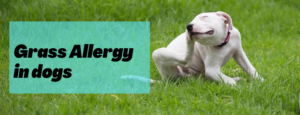 Grass Allergies in Dogs: What Are They?
Grass Allergies in Dogs: What Are They?
Grass allergies, which are widespread in dogs, are inhalant allergies caused by pollen found in grasses. Grass pollens are airborne, therefore your dog does not need to be on the grass to experience symptoms. Grass allergies can cause skin irritation or upper respiratory problems.
Grass allergies are more common in the spring and fall, when grass pollen is more widespread because to the diversity of seasonal species, but they can affect your dog at any time of year. Allergens (grass pollens) are absorbed through the skin and mucous membranes in dogs. Flea and food allergies are common in dogs with grass allergies.
Grass allergies can strike at any age, but due to earlier exposure to the allergens, most dogs develop allergies after the age of one. While some of the symptoms may be bothersome to your dog, the majority are not life-threatening.
Grass Allergy Symptoms in Dogs
Grass allergy can cause the following symptoms:
- Redness of the skin (erythema)
- Constant itching
- Scratching
- Licking
- Pruritus is the chewing of the cheeks, feet, armpits, and sides of the body.
- A rash may emerge, however because to a dog’s haircoat, redness and a visible rash may be difficult to spot.
Grass Allergies in Dogs: What Causes Them?
Grass allergies, which are caused by pollen from grasses like Bermuda, fescue, alfalfa, or rye, exhibit symptoms that are similar to pollen allergies caused by trees (cedar, pine, oak) and weeds (ragweed, pigweed).
Direct contact with the grass can cause symptoms in dogs who enjoy rolling in it. Others may get symptoms as a result of inhaling pollen while walking or simply being in an area where grass pollen is present, even indoors.
During the spring and fall seasons, when grass is growing and pollen produces a yellow trail of dust behind, this happens regularly. If pollen comes into touch with a dog’s mucous membranes (nose, eyes, mouth), skin, or feet when walking through an area where pollen is present, the dog may get symptoms.
Grass Allergies in Dogs: How Do Veterinarians Diagnose Them?
Your veterinarian will take a detailed history of your dog’s symptoms, including their length, severity, seasonality, and therapy (if any).
A thorough examination of the haircoat and skin would be the next step. The distribution of hair loss, any skin lesions such as pimples, rashes, dry or oily skin, scratches (excoriations) due to itching, redness, or skin irritation (to indicate inflammation), and scratches (excoriations) due to itching, redness, or skin irritation (to indicate inflammation) will all aid in determining the diagnosis.
Depending on the situation, treatment can be started based solely on clinical symptoms, with no more tests required. Further testing may be required if topical or conservative therapies are ineffective.
Treatment of Grass Allergies in Dogs
- Shampooing your pet with a hypoallergenic or gentle oatmeal-based pet shampoo: Bathing on a regular basis will assist to eliminate allergens before they may be absorbed into the skin. This may aid in the prevention or reduction of itching. Oatmeal shampoos are available without a prescription from a variety of companies.
- Cleanliness after outdoors: After coming inside from outside, make sure your dog’s feet and body are clean. This can help prevent licking and chewing of the feet, which is a symptom of itching. Mild soap and water, aloe pet wipes, or medicinal wipes with an antibacterial and antifungal component are all options.
- Antihistamines: Benadryl may help with watery eyes, a runny nose, and sneezing, but it rarely helps with allergic skin disorders (allergic dermatitis). Before giving your dog any medication, even over-the-counter meds, talk to your vet about the dosage.
- Hydrocortisone shampoo or hydrocortisone sprays: These products are commonly available over-the-counter and can help relieve the mild discomfort of red, itchy skin. Use only lotions and ointments designed for people. These products aren’t designed for pets, and the thicker ointments/creams may bring attention to the region and encourage additional licking, aggravating the irritation.

